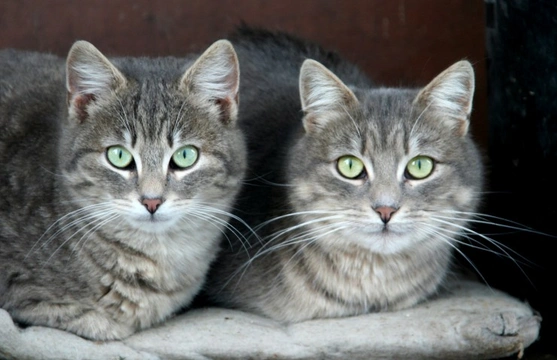
Copy cats - Different behaviours cats can learn and exhibit through mimicry
Compared to dogs, cats are rather a closed book when it comes to interpreting their thoughts, emotions and actions, and cats are often very subtle when it comes to expressing their feelings and preferences. Additionally, cats are largely thought of by most owners as animals that cannot be trained or taught new skills – but this isn’t strictly true.
Cats are entirely capable of learning tricks and commands and have the intelligence and memory skills to do so – but they don’t have the same motivations as dogs do and ultimately, with the odd exception, don’t tend to see the point.
However, cats learn a lot from other cats, both in the case of young kittens who are still living with their siblings and queen, and in the case of adult cats that live with others or come into contact with other cats in the neighbourhood too.
Cats learn a lot of things simply through observing the behaviours of their fellow felines – and there are a surprising number of traits and defined actions that you may find your cat has picked up simply through observation and mimicry.
Read on to learn more about some of the different behaviours that cats can learn and copy from other cats.
Grooming
Cats are as a whole very finnicky about their personal hygiene, and they spend large portions of the day licking and grooming their coats and ensuring that they are scrupulously clean. Kittens first learn about grooming themselves from their dams, and in some (but not all) cases of kittens who are hand-reared, the kittens won’t start to really take care of their own grooming until they get older, and potentially see another cat washing themselves.
Additionally, if you own two or more cats, watch closely next time they’re all in the same room and one of them starts grooming themselves – you may find that one (or more) of the other cats also start grooming themselves in short order!
Hunting
Cats have a very strong prey drive, which is innate to the species and manifests naturally in virtually all cats without being taught to hunt. However, learning to hunt successfully, and mimicking hunting behaviour through play with toys and other cats is something that kittens are again taught by their mothers, and a queen that loves to hunt will usually pass this onto their own offspring, both as a hereditary trait and through showing them what to do.
Yawning
Yawning is not only contagious between people, but it also crosses the species divide – again, if you own two or more cats, you will probably notice that if one of them yawns, other feline observers will soon follow suit!
Vocalisations
Some cats are naturally more chatty than others, with the Bengal and the Siamese being prime examples – but cats rarely communicate with each other vocally in the wild, and generally, hone and save their conversations and verbal demands for people, as they have learned that this gets results!
However, if you keep one cat that meows a lot and that has a whole vocabulary of different communications that they use for different things and then get another kitten or even an adult cat, you may find that the new cat not only tends to become more vocal in general, but also, that they will learn and mimic the vocal cues used by the other cat too.
How to play
Whilst not all cats are very playful, having one cat that is always pouncing on things or looking for ways to get into mischief will usually have an effect on any other cats that live with you too. Sometimes this may mean that the less playful cat will become the unwilling target of the odd well-timed pounce, but equally as likely, the less playful cat will be enticed out to play.
If one cat is stalking a toy or imaginary mouse and is paying full attention to it, this is likely to catch the eye of any other cat that lives with them, and they will also want to know what is going on.
How involved they get in the game will of course vary – but living with another active or playful cat will usually have a knock-on effect on the activity levels of their housemates too!
Respecting personal space
Given how inquisitive cats are and how they like to get involved in everything, cats are also very good at giving each other space, and respecting the territories of other cats, both within the home and outside.
Cats tend to have their own preferred bed, perch and resources that they prefer not to share, even with another cat that lives with them – and cats are adept at showing the appropriate amount of deference and respect for things that are not theirs, in order to avoid friction with other cats.
Even when it comes to territories outside of the home, cats tend to develop complex relationships and understandings with other cats, and stick to fairly static territories.



